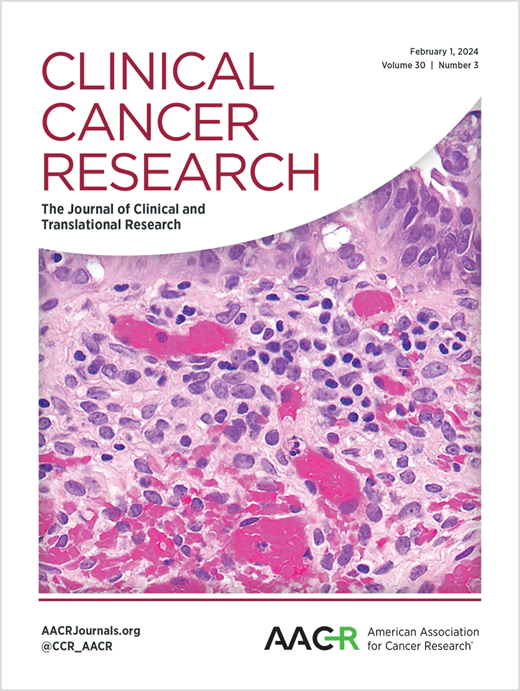INTERLINK-1:单抗联合西妥昔单抗治疗复发/转移性头颈部鳞状细胞癌的III期、随机、安慰剂对照研究
IF 10
1区 医学
Q1 ONCOLOGY
引用次数: 0
摘要
目的:在免疫检查点抑制剂(ICI)治疗和铂基化疗失败后,复发/转移(R/M)头颈部鳞状细胞癌(HNSCC)的治疗选择有限。初步数据显示单抗联合西妥昔单抗在R/M型HNSCC中具有临床活性。参与者和方法:INTERLINK-1 (NCT04590963)是一项双盲III期研究。接受过ICI治疗的R/M HNSCC患者,尽管以铂为基础的化疗仍有进展,他们被2:1随机分配到单抗(750 mg,每两周)或安慰剂加西妥昔单抗(400 mg/m2,然后250 mg/m2,每周)。主要终点是非口咽癌(OPC)或人乳头瘤病毒(HPV)阴性OPC (HPV无关分析集)患者的总生存期(OS)。次要终点包括无进展生存期(PFS)和客观缓解率(ORR)。结果:截止数据时,216名参与者被随机纳入hpv无关分析组;单抗加西妥昔单抗145例,安慰剂加西妥昔单抗71例。单抗+西妥昔单抗的中位生存期为8.8个月,而安慰剂+西妥昔单抗的中位生存期为8.6个月(风险比[HR], 1.00;95% ci, 0.66-1.54);中位PFS分别为3.6个月和3.8个月(HR, 1.11;95% ci, 0.79-1.57);ORR分别为15.2%和23.9%。在预先计划的中期分析显示符合无效标准后终止INTERLINK-1(预定无效HR &;gt;0.874)。monalizumab组和安慰剂组分别有18.3%和17.2%的参与者报告了3-4级治疗相关不良事件。结论:与安慰剂加西妥昔单抗相比,单抗加西妥昔单抗不能改善OS。联合用药的安全性与西妥昔单抗的安全性观察结果一致。本文章由计算机程序翻译,如有差异,请以英文原文为准。
INTERLINK-1: A Phase III, Randomized, Placebo-Controlled Study of Monalizumab Plus Cetuximab in Recurrent/Metastatic Head and Neck Squamous Cell Carcinoma
Purpose: Treatment options for recurrent/metastatic (R/M) head and neck squamous cell carcinoma (HNSCC) after failure of immune checkpoint inhibitor (ICI) treatment and platinum-based chemotherapy are limited. Preliminary data suggested monalizumab plus cetuximab had clinical activity in R/M HNSCC. Participants and methods: INTERLINK-1 (NCT04590963) was a double-blind, phase III study. Participants with R/M HNSCC who had received ICI therapy and progressed despite platinum-based chemotherapy were randomized 2:1 to monalizumab (750 mg, fortnightly) or placebo, plus cetuximab (400 mg/m2 loading dose, then 250 mg/m2, weekly). The primary endpoint was overall survival (OS) in participants with non-oropharyngeal cancer (OPC) or human papillomavirus (HPV)-negative OPC (HPV-unrelated analysis set). Secondary endpoints included progression-free survival (PFS) and objective response rate (ORR). Results: At data cut-off, 216 participants were randomized in the HPV-unrelated analysis set; 145 to monalizumab plus cetuximab and 71 to placebo plus cetuximab. Median OS was 8.8 months for monalizumab plus cetuximab versus 8.6 months for placebo plus cetuximab (hazard ratio [HR], 1.00; 95% CI, 0.66–1.54); median PFS was 3.6 versus 3.8 months, respectively (HR, 1.11; 95% CI, 0.79–1.57); and ORR was 15.2% versus 23.9%, respectively. INTERLINK-1 was terminated after a preplanned interim analysis showed futility criteria were met (predetermined futility HR >0.874). Grade 3–4 treatment-related adverse events were reported in 18.3% and 17.2% of participants treated in the monalizumab and placebo arms, respectively. Conclusions: Monalizumab plus cetuximab did not improve OS compared with placebo plus cetuximab. The safety profile of the combination was consistent with safety observations for cetuximab monotherapy.
求助全文
通过发布文献求助,成功后即可免费获取论文全文。
去求助
来源期刊

Clinical Cancer Research
医学-肿瘤学
CiteScore
20.10
自引率
1.70%
发文量
1207
审稿时长
2.1 months
期刊介绍:
Clinical Cancer Research is a journal focusing on groundbreaking research in cancer, specifically in the areas where the laboratory and the clinic intersect. Our primary interest lies in clinical trials that investigate novel treatments, accompanied by research on pharmacology, molecular alterations, and biomarkers that can predict response or resistance to these treatments. Furthermore, we prioritize laboratory and animal studies that explore new drugs and targeted agents with the potential to advance to clinical trials. We also encourage research on targetable mechanisms of cancer development, progression, and metastasis.
 求助内容:
求助内容: 应助结果提醒方式:
应助结果提醒方式:


